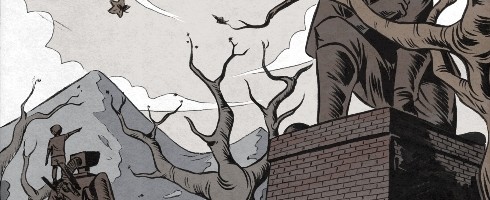Released: 14.04.13
The wondrous sonic experimentalist that is Sone Institute presents Collision/Detection v9 aka DeathBeat.
Sone Institute is the home of Roman Bezdyk, mercurial curator of two out there albums, Curious Memories(2010) and A Model Life (2012), and a collaboration with Dollboy, The Sum and The Difference. His Collision/Detection EP is the soundtrack to 1983 horror classic DeathBeat. Hell has a new beat. It is called death…
DeathBeat
(1983) Film Synopsis.
Where Sex, horror and vinyl collide on turntables of blood and bodily fluids.
“You know you are dying for it… and you will baby”
“I call her Sister Sledge, Sister Sledge hammer” as the cold
steel pulverized her wretched smiling, sluttish face.
“…Blood spewed from the soft opening like milk from a mesmerized baby’s mouth.”
Hell has a new beat. It is called death…
The year is 1983 and DeathBeat, New York’s finest nightclub is celebrating its 1st birthday.
What could go wrong?
Housed in the beautiful Gothic Smoking Dog building. Once home to the experimental asylum for sexually deranged and monstrously violent patients way back in 1953.
Today also happens to be the 30th anniversary of the 78 patient’s horrific termination by its very own deranged medical director – mercilessly hacked to pieces one by one while under the influence of the drug Kajja. The dead souls of the patients now pray in their fear sodden death chambers never to be woken to the rotten earthly pleasure that brought them here in the first place. Or, to the sick flesh pursuits of their hell flamed desires.
Kajja’s main side effect is to induce a relentless throbbing pulse wave of 69 beats per minute (bpm) in patient’s / users skulls, due to a psychic irregularity and sonic displacement of 69 bpm. Induced by DJ Beak’s double groove sensual pleasure DJ set, tonight hell will manifest itself in DeathBeat Discothèque.
They have returned for one final dance.
Why and how they have returned, earth dare not comprehend.
For what?
The revellers can only scream inside their putrid, vile brains and beg for their pointless, Godless lives to be extinguished.
1. DeathBeat 1 (Main title sequence)
Hope and affluence reign in the club of distinction. Money, sex and power are the new Gods. Man is his own master- the supreme being of all. DJ Beak reigns untouched with his blend of double groove frottage scratch technique.
2. Unguarded Circle of Flesh (Decapitated head sequence)
The first set of heads and mutilated genitals are discovered rotating at 45 rpm on the gold plated Technics 1210’s, but the beat goes on…
3. Flesh Dance (In a state of perpetual arousal)
Chased by institutionalized reincarnations of lascivious inpatients, they attempt to fornicate with the big hair styled and shoulder-padded patrons of the club. Unfortunately their idea of climax always ends in death…
4. DeathBeat 2 (Film end title sequence)
The Club lights continue to flash. A muffled beat relentlessly throbs. A lone female’s voice sobs. Trembling like a demented gerbil in the corner of the dance floor. The camera pans across the dance floor which drips in blood, seminal fluids, tears, half eaten brains and fear induced piss.
The revolution will be digitalized.
Let the process begin!
The End.



